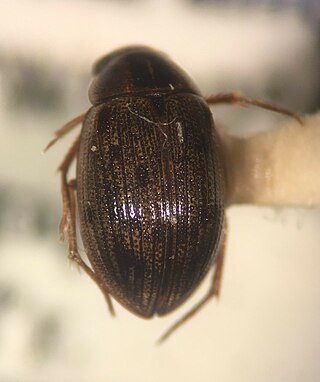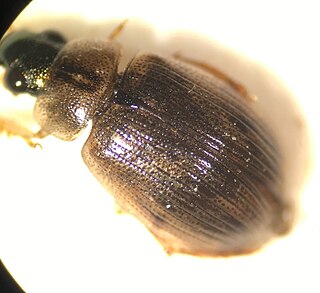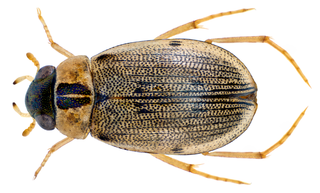
Convolvulaceae, commonly called the bindweeds or morning glories, is a family of about 60 genera and more than 1,650 species. These species are primarily herbaceous vines, but also include trees, shrubs and herbs. The tubers of several species are edible, the best known of which is the sweet potato.

Great Basin National Park is an American national park located in White Pine County in east-central Nevada, near the Utah border, established in 1986. The park is most commonly entered by way of Nevada State Route 488, which is connected to U.S. Routes 6 and 50 by Nevada State Route 487 via the small town of Baker, the closest settlement.

The Cape Fear River is a 191.08-mile-long blackwater river in east-central North Carolina. It flows into the Atlantic Ocean near Cape Fear, from which it takes its name. The river is formed at the confluence of the Haw River and the Deep River in the town of Moncure, North Carolina. Its river basin is the largest in the state: 9,149 sq mi.

Berosus is a lunar impact crater that is located in the northeast part of the Moon, less than one crater diameter northwest of Hahn. Further to the east-northeast is the large crater Gauss, and to the north-northwest lies Bernoulli. Because of its location, this crater appears foreshortened when viewed from the Earth.

Nyctaginaceae, the four o'clock family, is a family of around 33 genera and 290 species of flowering plants, widely distributed in tropical and subtropical regions, with a few representatives in temperate regions. The family has a distinctive fruit type called an accessory fruit or anthocarp, and many genera have extremely large pollen grains.

The Oyster River is a 17-mile-long (27 km) river in Strafford County, southeastern New Hampshire, United States. It rises in Barrington, flows southeast to Lee, then east-southeast in a serpentine course past Durham to meet the entrance of Great Bay into Little Bay. The bays are tidal inlets of the Atlantic Ocean, to which they are connected by a tidal estuary, the Piscataqua River. The freshwater portion of the river is 14.1 miles (22.7 km) long, and the tidal river extends 2.9 miles (4.7 km) from Durham to Great Bay.

Berosus is a genus of beetles in the family Hydrophilidae, the water scavenger beetles. The genus contains 273 species. It is distributed worldwide.

Berosus exiguus is a species of water scavenger beetles found in the United States, the Bahamas, and Cuba. These beetles are small, ranging from 2.0 to 3.5 mm in length. They can be identified by their small size, yellowish-brown head, distinctly impressed elytral striae (stripes), and often faint spots on the elytra.

Berosus infuscatus is a species of hydrophilid beetle from the United States, Mexico and Cuba.
Berosus metalliceps is a species of hydrophilid beetles from the United States, Mexico, the Bahamas and Cuba.

Berosus sayi is a species of hydrophilid beetles native to the United States. It is a synonym of Berosus striatus, which was originally described by Thomas Say in 1825, and females can be characterized by a small tooth on the suture near the apex of each elytron.

Berosus youngi is a species of water scavenger beetle found in the United States.

Berosus fraternus is a species of water scavenger beetle in the family Hydrophilidae. It is found in North America.
Berosus hatchi is a species of water scavenger beetle in the family Hydrophilidae. It is found in North America.

Proteides mercurius, the mercurial skipper, is a species of dicot skipper in the butterfly family Hesperiidae. It is found in the Caribbean Sea, Central America, North America, and South America.
Aradus funestus is a species of flat bug in the family Aradidae. It is found in North America.
Aradus depictus is a species of flat bug in the family Aradidae. It is found in North America.

Cricotopus sylvestris formerly Cricotopus silvestris, is a species of midge in the family Chironomidae. It is found in Asia, Europe, The United Kingdom, and North America.

Berosus pulchellus, is a species of water scavenger beetle found in Oriental, Australasian, Afrotropical and Palaearctic regional countries such as India, Sri Lanka, Hong Kong, Japan, Iran, Cambodia and Australia.
Berosus amoenus is a species of hydrophilid beetle endemic to the Northern Territory (Australia) which was first described in 1987 by Chris H.S. Watts.















